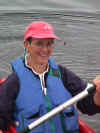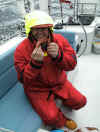| Alaska Log #9 Ganges, Saltspring Island, B.C.
September 1, 1999
(Click on each photo to see it full size)
 No, we didn't sink. Still cruising,
even though it's been a month since we sent you our last log. A lot has happened. Guests
from New Zealand (Lise and Bjarne), a gale, heavy rain for 10 days straight, 800+ miles
travelled and lots of adventures. Since this is our 100th night out on the
water, it seemed like a fitting time to write. No, we didn't sink. Still cruising,
even though it's been a month since we sent you our last log. A lot has happened. Guests
from New Zealand (Lise and Bjarne), a gale, heavy rain for 10 days straight, 800+ miles
travelled and lots of adventures. Since this is our 100th night out on the
water, it seemed like a fitting time to write.
 One big adventure was the transit of El Capitan Passage in
Alaska. It's like the Panama Canal of Alaska - 3 miles long, 25 feet wide, and about 10
feet deep. Since we need 6 1/2 feet to keep afloat, this was cutting it a bit fine. Parts
of the Passage are a dredged channel, and all we could think was, "I hope they didn't
get their dredging budget cut this year!" We did the trip at low tide, which was a
little scary since we could see all the hazards, but at least we knew the rising tide
would save us from any severe oversights. There were big piles of rock along the way that
had been blasted out of the canal. The passage was too narrow for turning around and no
passing room. We kept calling ahead on the radio to make sure no one else was coming
towards us. Two pleasure boats would never have fit side by side, let alone a tug and
barge, which use this passage frequently. One section was called Dry Pass, not a
comforting name! But we survived. Two hours of nerves, but we took lots of pictures, which
can't begin to show the intriguing situation. One big adventure was the transit of El Capitan Passage in
Alaska. It's like the Panama Canal of Alaska - 3 miles long, 25 feet wide, and about 10
feet deep. Since we need 6 1/2 feet to keep afloat, this was cutting it a bit fine. Parts
of the Passage are a dredged channel, and all we could think was, "I hope they didn't
get their dredging budget cut this year!" We did the trip at low tide, which was a
little scary since we could see all the hazards, but at least we knew the rising tide
would save us from any severe oversights. There were big piles of rock along the way that
had been blasted out of the canal. The passage was too narrow for turning around and no
passing room. We kept calling ahead on the radio to make sure no one else was coming
towards us. Two pleasure boats would never have fit side by side, let alone a tug and
barge, which use this passage frequently. One section was called Dry Pass, not a
comforting name! But we survived. Two hours of nerves, but we took lots of pictures, which
can't begin to show the intriguing situation.
One of the most "interesting" nights we've spent, our kiwi
friends called The Battle of Bruce and Gale. We were in an allegedly protected anchorage
called Newcombe Harbour. When we set our prawn pots at the entrance to the harbor, the
floats disappeared; 600 feet of line, float, pot, bait and all. One minute they were
there, and the next minute they were gone. Since we knew the depth was OK, this was
inexplicable. Turned out to be a strong flood tide current. As the evening wore on, Jan
and our NZ friend, Bjarne, braved the rising wind and rescued the pots at slack tide.
 By that time the Coast Guard had put out a gale warning, but we figured
we were in a very secure spot. The wind kept rising, bringing pelting rain with it during
the night. Jan kept letting out more anchor chain, but Bruce (you remember how fond we are
of him; he's our close friend the 176 lb. anchor) was holding tight. All was well, if
noisy. In the middle of the night, in the pitch black, storms always seem a lot worse. Jan
has an instrument over his berth that shows the wind, depth, etc. We watched the gusts hit
40 and then we heard a bang and lots of clanks. Jan and Bjarne hopped into their foul
weather gear and went out on deck to survey the damage. The anchor chain had twisted a
four-inch stainless steel chain hook and the chain had run out a few more feet. Deck
lights on, flashlights playing on the rocks to either side of us, they rigged an even
bigger hook (one the first mate could hardly lift in the morning). And then all four of us
finally got some sleep. By that time the Coast Guard had put out a gale warning, but we figured
we were in a very secure spot. The wind kept rising, bringing pelting rain with it during
the night. Jan kept letting out more anchor chain, but Bruce (you remember how fond we are
of him; he's our close friend the 176 lb. anchor) was holding tight. All was well, if
noisy. In the middle of the night, in the pitch black, storms always seem a lot worse. Jan
has an instrument over his berth that shows the wind, depth, etc. We watched the gusts hit
40 and then we heard a bang and lots of clanks. Jan and Bjarne hopped into their foul
weather gear and went out on deck to survey the damage. The anchor chain had twisted a
four-inch stainless steel chain hook and the chain had run out a few more feet. Deck
lights on, flashlights playing on the rocks to either side of us, they rigged an even
bigger hook (one the first mate could hardly lift in the morning). And then all four of us
finally got some sleep.
 Along about Gale's arrival, we
decided to make use of all the rain that was falling on us. Raven is designed so that all
the rain water drains in channels along the sides of the boat, called scuppers. After the
rain washes the boat down well, you can make a little dam at the stern of the boat, open
up the water tanks and collect away. We added about 250 gallons of nice, pure rainwater to
our tanks in about 8 hours. It made us feel like we were at least doing something
constructive about the weather. We began to run out of drying room for all our foul
weather gear, though, since all four of us had two sets going, plus boots, hats, gloves
etc. We were not a good advertisement for cruising in the Pacific Northwest. Along about Gale's arrival, we
decided to make use of all the rain that was falling on us. Raven is designed so that all
the rain water drains in channels along the sides of the boat, called scuppers. After the
rain washes the boat down well, you can make a little dam at the stern of the boat, open
up the water tanks and collect away. We added about 250 gallons of nice, pure rainwater to
our tanks in about 8 hours. It made us feel like we were at least doing something
constructive about the weather. We began to run out of drying room for all our foul
weather gear, though, since all four of us had two sets going, plus boots, hats, gloves
etc. We were not a good advertisement for cruising in the Pacific Northwest.
We met Gale again a week or two later as we motored down Johnstone
Strait, which has a reputation for being the wind tunnel of the Northwest. The predictions
were for 15 to 20 knot winds, not a big deal for Raven. We were also going downwind, which
helped considerably. The wind gradually picked up all day until we had 30-35 knots steady
and gusts to 40, and were surfing down 6 foot waves. We were fine, but it was all
unexpected. Later in the day the Coast Guard issued a "Special Weather
Conditions" report, finally telling everyone how it really was in Johnstone.
  Over the summer we have improved our
skills as hunter-gatherers. Despite our bad luck with prawns in Newcombe, we have been
bringing up pots full of 100 or so spot prawns and smaller shrimp. They are so
sweet when cooked fresh! The
crabbing had not been as good until we hit Blunden Harbour where we brought up one pot with
42 Dungeness crabs in it! Admittedly, only 4 were keepers, but still, that wasn't bad for
the end of the season. The 42 in the crab pot were having a real melee, and it took Jan
and Bjarne about an hour to sort them all out. We've also improved our fishing technique,
called mooching. Now, mooching has two meanings. In the fishing world it means to put your
lure down to a certain depth and move it up and down slowly. In Twardowski Terminology,
mooching is accepting all the fish that friends want to give away. We've met lots of very
experienced fishermen (or fishers as they're known in PC) and they always seem to have
more fish than they can use. We even passed one fish between boats in a net, so we really
did "catch" it. Over the summer we have improved our
skills as hunter-gatherers. Despite our bad luck with prawns in Newcombe, we have been
bringing up pots full of 100 or so spot prawns and smaller shrimp. They are so
sweet when cooked fresh! The
crabbing had not been as good until we hit Blunden Harbour where we brought up one pot with
42 Dungeness crabs in it! Admittedly, only 4 were keepers, but still, that wasn't bad for
the end of the season. The 42 in the crab pot were having a real melee, and it took Jan
and Bjarne about an hour to sort them all out. We've also improved our fishing technique,
called mooching. Now, mooching has two meanings. In the fishing world it means to put your
lure down to a certain depth and move it up and down slowly. In Twardowski Terminology,
mooching is accepting all the fish that friends want to give away. We've met lots of very
experienced fishermen (or fishers as they're known in PC) and they always seem to have
more fish than they can use. We even passed one fish between boats in a net, so we really
did "catch" it.
We're headed for home now and expect to be in Tacoma about the 10th,
which will be just about four months after we left. The summer has sped by, and we
discovered we love cruising together. If the weather were better, we'd keep on going, but
we are definitely in a fall weather pattern now, so we'll come back and sit by the fire
until it goes away.
Warm regards . . . Signe and Jan |